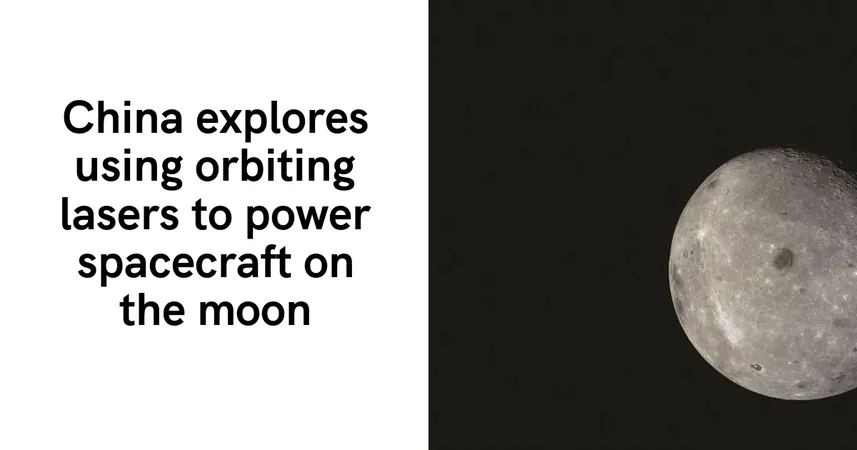
China Innovates with Laser Power Transmission for Lunar Exploration – A Game Changer!
2025-01-21
Author: Li
Groundbreaking Development in Lunar Exploration Technology
In a groundbreaking development in lunar exploration technology, China is delving into the use of laser power transmission from orbit to supply power to spacecraft on the moon. This innovative approach aims to tackle a major challenge facing lunar missions: operating during the moon's long nights, which can last up to 14 Earth days and expose equipment to frigid temperatures that plummet to -200 degrees Celsius (-328 degrees Fahrenheit).
Feasibility of Wireless Laser Power Transmission (WLPT)
Recent research has explored the feasibility of Wireless Laser Power Transmission (WLPT) from orbiting satellites to lunar surface vehicles, offering a potential lifeline for spacecraft stranded in darkness or located in the eternally shadowed regions of the moon, believed to harbor valuable water-ice resources. This technology leverages concentrated beams of lasers to transmit energy, which are then converted into electricity by the receivers on the lunar surface.
Applications and Benefits of WLPT
One of the most promising applications of WLPT includes not only powering equipment during lunar nights but also enhancing operations in shaded craters, vital for resource extraction, including water and oxygen production for future astronauts. Unlike traditional power sources such as radioisotope generators, which are limited in output and expensive, laser power systems could offer a more flexible and scalable solution, as asserted in a recent study published in the Journal of Deep Space Exploration.
Challenges and Recommendations
While the concept of WLPT holds exciting potential, challenges remain. Key hurdles include improving transmission efficiency, increasing operational range, and ensuring that lasers can effectively target their receivers—issues that researchers emphasize must be met with further technological development. “It is essential to prioritize the advancement of high-power laser systems and to initiate on-orbit testing without delay,” the authors recommend.
Alignment with China's Lunar Exploration Plans
This initiative aligns closely with China's ambitious lunar exploration plans, notably the establishment of the International Lunar Research Station (ILRS). Set to be developed throughout the 2030s, the ILRS will serve as a central hub for sustained lunar exploration and resource utilization. Precursor missions, such as Chang’e-7 and Chang’e-8, slated for launch in 2026 and 2028, respectively, will land in the moon's south pole, strategically focused on assessing resource availability and testing in-situ resource utilization technologies.
Broader Context of Space-Based Power Generation
In a broader context, China is also investigating the potential for space-based solar power, which aims to generate electricity in geostationary orbit for transmission back to Earth. By experimenting with such technologies on the Tiangong space station, China hopes to advance its capabilities in efficient power generation not only for lunar bases but also for terrestrial needs.
A New Era of Exploration
Moving forward, the successful implementation of WLPT could position China as a leader in the arena of sustainable lunar exploration, addressing crucial energy requirements and expanding humanity's reach beyond Earth. As we stand on the brink of a new era of exploration, the hope is that such innovations will pave the way for a thriving extraterrestrial presence in the not-so-distant future.




 Brasil (PT)
Brasil (PT)
 Canada (EN)
Canada (EN)
 Chile (ES)
Chile (ES)
 Česko (CS)
Česko (CS)
 대한민국 (KO)
대한민국 (KO)
 España (ES)
España (ES)
 France (FR)
France (FR)
 Hong Kong (EN)
Hong Kong (EN)
 Italia (IT)
Italia (IT)
 日本 (JA)
日本 (JA)
 Magyarország (HU)
Magyarország (HU)
 Norge (NO)
Norge (NO)
 Polska (PL)
Polska (PL)
 Schweiz (DE)
Schweiz (DE)
 Singapore (EN)
Singapore (EN)
 Sverige (SV)
Sverige (SV)
 Suomi (FI)
Suomi (FI)
 Türkiye (TR)
Türkiye (TR)
 الإمارات العربية المتحدة (AR)
الإمارات العربية المتحدة (AR)